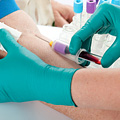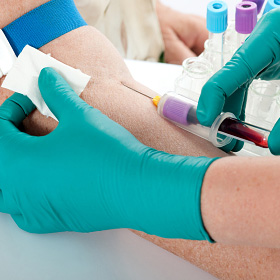(HbA1C, Glycated Hemoglobin, Glycosylated Hemoglobin, Diabetic Control Index, A1C)

A patient having a blood sample collected.
The HbA1C test measures the amount of glycated hemoglobin (HbA1C) in your blood. Hemoglobin is the oxygen carrier in red blood cells and it becomes glycated hemoglobin when there is too much sugar in the blood. This test provides an indication of blood sugar control over the last 3 months.
Your doctor may request this test to see how well your diabetes is being managed, and if your therapy needs to be modified. Consistently high levels of HbA1C put you at greater risk of developing complications from diabetes.
This test is usually performed by a doctor or nurse in a doctor's office and involves a blood sample collection. The number of times the test is performed yearly depends on how well your blood sugar levels are controlled and if your medications are being adjusted. In general, the test is done every 3 to 6 months.
Risks and precautionsThe hemoglobin A1C test is usually a straightforward and safe test. However, there are some risks of complications or side effects, including:
- infection (redness, swelling, pus)
- bruising at the blood collection site
- excess bleeding from the blood collection site
- lightheadedness or dizziness
Get immediate medical assistance if you experience any of these complications or side effects.
Some conditions or medications may put you at greater risk of side effects or complications. Tell your doctor if you have bleeding disorders or are taking medications that impair blood clotting (e.g., warfarin, ASA, etc.).
It is important that you understand all the risks of complications and side effects of the test, and what you or your doctor can do to avoid them. Make sure that your doctor is aware of all your concerns.
Some people may experience complications or side effects other than those listed. Check with your doctor if you notice any symptom that worries you after your test.
During the testThe HbA1C test involves taking a blood sample, which generally takes a few minutes.
- A nurse ties a wide elastic band around your upper arm to help locate the vein.
- The nurse will use alcohol to disinfect the area and then insert a needle into the skin. You might feel a slight prick when the needle is inserted.
- After the blood is collected, the needle is removed and the blood sample is sent to the laboratory.
- A cotton ball can be used to stop any mild bleeding and a nurse may place a bandage over the needle site.
Before the testYou do not need to do anything to prepare for this test.
It is important that you fully understand what the test involves beforehand. Ask your doctor to explain the risks, benefits, and drawbacks of the test, and don't be shy to probe further until you are comfortable with your doctor's responses.
If you are taking any prescription or over-the-counter (non-prescription) medications, supplements, or herbal products, make sure you inform your doctor or pharmacist. Ask them whether it is necessary for you to stop taking any of these medications and products before the test. It is also important to tell them if you have allergies to certain medications, bandages, latex, or have other medical conditions.
After the testIt is normal to feel these side effects after this test:
- tenderness or bruising at the injection site
- throbbing in your arm
Ask your doctor when you can expect your test results to be made available. HbA1C is reported as a percentage and it is generally ideal to have an HbA1C value of less than 7%. However, this target varies based on a number of factors, and you should ask your doctor what your target level should be.

A patient having a blood sample collected.